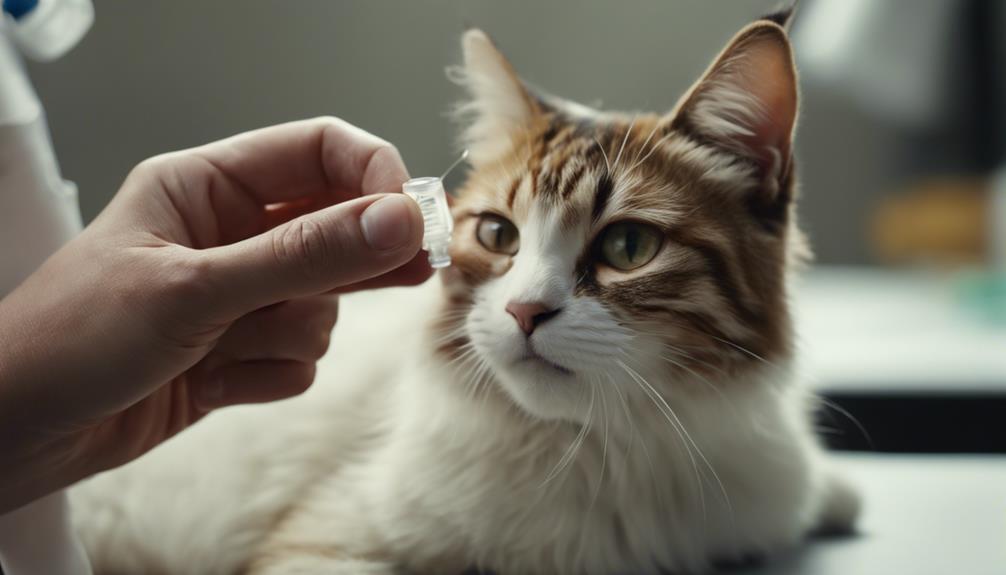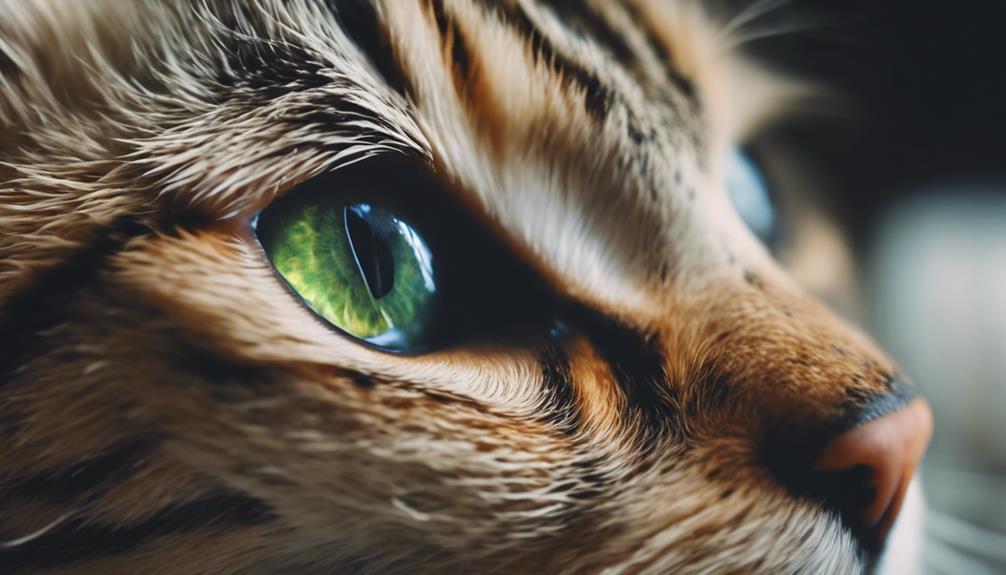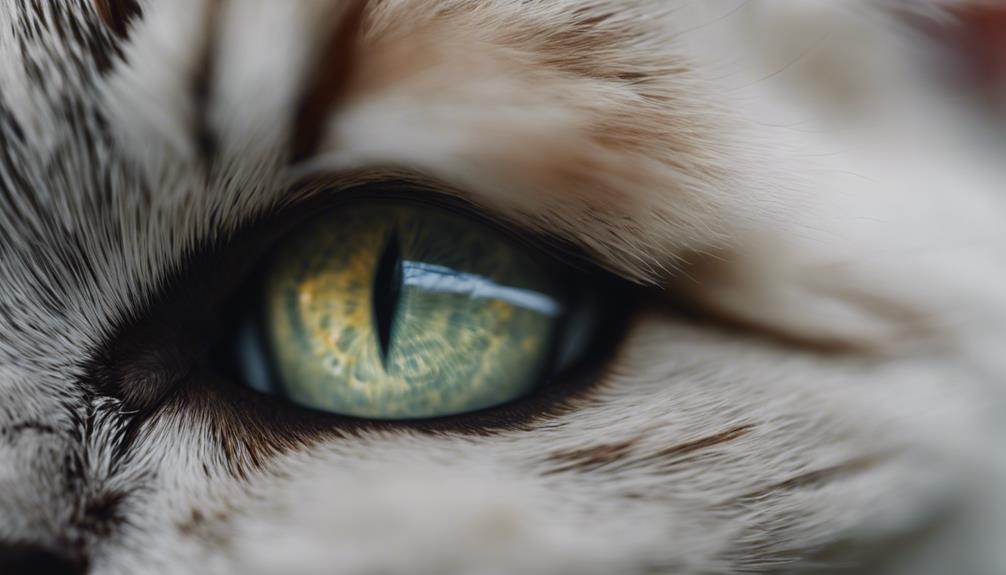Cat cataracts pose a significant concern for feline health, impacting their visual capabilities and overall quality of life. Understanding the intricacies of this eye condition is vital for pet owners seeking to navigate potential diagnosis and treatment pathways.
With a focus on causes, symptoms, and management strategies, unraveling the complexities of cat cataracts can empower caregivers to make informed decisions regarding their feline companions' ocular well-being.
Stay tuned to uncover essential insights into cat cataracts and how best to support cats facing this condition.
Key Takeaways
- Cat cataracts involve lens changes affecting vision.
- Genetic predisposition and age are common risk factors.
- Surgery is the main treatment for cataracts in cats.
- Regular veterinary check-ups aid in early cataract detection.
Cat Cataracts Overview
Cat cataracts, a common feline eye condition, involve a lens change that can impact a cat's vision as they age. These cataracts typically start small but can progress, obstructing light from reaching the retina. While some cataracts may not significantly affect vision, others can lead to visual impairment.
Nuclear sclerosis, a common age-related lens change in cats, can sometimes be mistaken for cataracts but usually doesn't cause vision loss. Cats have the ability to adapt to minor vision impairments caused by cataracts. Understanding the progression of cataracts and their impact on a cat's vision is crucial for timely intervention and management to maintain the feline's eye health and overall quality of life.
Causes and Risk Factors
Causes and risk factors contributing to the development of cataracts in cats include genetic predisposition, age-related changes, trauma, inflammation, and specific breed susceptibilities.
- Genetic predisposition: Certain cat breeds have a higher likelihood of developing cataracts due to inherited factors.
- Age-related changes: Cataracts typically appear in cats after the age of 10, as the lens undergoes natural degenerative processes.
- Trauma: Physical injuries to the eye can lead to the formation of cataracts in cats.
- Inflammation: Eye infections or diseases like uveitis can contribute to cataract development in felines.
- Specific breed susceptibilities: Breeds such as Himalayan, Birman, and Persian cats are genetically prone to cataracts, requiring special attention to eye health.
Treatment Options for Cats

When addressing feline cataracts, the primary approach for management involves surgical intervention to remove the affected lens and restore vision in cats. Surgery is the most common and effective treatment option for cats with cataracts.
During the procedure, the cloudy lens is removed, and an artificial lens may be inserted to improve vision. Post-surgery care is crucial and may include wearing a cone to prevent the cat from rubbing its eyes and administering prescribed eye drops to aid in the healing process.
It is important to note that not all cats with cataracts require treatment, especially if the cataracts are not significantly affecting their vision. However, untreated cataracts can lead to complications such as glaucoma, which can result in pain and further vision impairment.
Surgical Procedure Details
During the surgical procedure for feline cataracts, the affected cloudy lens is meticulously removed to restore the cat's vision and improve ocular health. The surgery involves delicate steps to ensure the best outcome for the feline patient.
- Anesthesia is administered to ensure the cat remains comfortable and still during the surgery.
- A small incision is made in the eye to access the cloudy lens.
- The cloudy lens is carefully broken apart and removed from the eye.
- An artificial lens may be implanted to replace the removed natural lens.
- The incision is closed, and the eye is allowed to heal under veterinary supervision.
Managing Feline Cataracts

After undergoing surgical removal of cataracts to restore vision, managing feline cataracts involves post-operative care and long-term monitoring to ensure optimal eye health for the cat.
Post-surgery, it is crucial to follow the veterinarian's instructions diligently. This includes administering prescribed eye drops, ensuring the cat wears a protective cone to prevent rubbing or scratching the eyes, and monitoring for any signs of infection or complications.
Regular follow-up appointments are essential to assess the healing process, monitor for any recurrence of cataracts, and address any other eye conditions that may arise.
Maintaining a healthy diet rich in antioxidants can also support overall eye health and potentially prevent future cataract development.
Preventing Cataracts in Cats
To minimize the risk of cataracts in cats, proactive measures such as maintaining a balanced diet rich in antioxidants and ensuring regular veterinary check-ups are essential. Along with these key steps, there are additional strategies that can help prevent cataracts in felines:
- Balanced Diet: Provide a diet rich in antioxidants like vitamin E and C.
- Regular Exercise: Encourage physical activity to support overall health.
- Eye Protection: Shield your cat's eyes from excessive sunlight exposure.
- Hydration: Ensure your cat stays well-hydrated to support eye health.
- Avoid Smoking Exposure: Keep your cat away from smoke, as it can contribute to eye issues.
Eye Health Resources for Pets

Exploring a comprehensive range of resources dedicated to promoting optimal eye health in pets is crucial for ensuring the well-being of our beloved animal companions. Below is a table highlighting various eye health resources for pets:
| Resource | Description | Target Audience |
|---|---|---|
| Counteracting Cataracts | Maintaining optimal eyesight in aging dogs | Dog Owners |
| Signs of eye infections in cats | Identifying and treating common eye infections | Cat Owners |
| Common eye problems in cats | Understanding and managing feline eye issues | Cat Owners |
| Understanding cloudy eyes in dogs | Recognizing causes and treatments for cloudy eyes | Dog Owners |
These resources offer valuable information to help pet owners detect, prevent, and manage eye-related issues in their furry friends.
Frequently Asked Questions
Can Cat Cataracts Be Passed on From a Mother Cat to Her Kittens?
Cataracts in cats can be genetic, potentially passed from mother to kittens. Breeds like Himalayan, Birman, and Persian are predisposed. Regular veterinary checks are crucial to identify and manage inherited conditions early for optimal eye health.
Are There Any Alternative Treatments, Aside From Surgery, for Cat Cataracts?
While surgery is the primary treatment for cat cataracts, alternative treatments like eye drops or specialized diets are not as effective. Consult with a veterinarian to explore options tailored to your cat's specific condition.
How Can Owners Help Their Cat Adjust to Vision Loss Caused by Cataracts?
Owners can help their cat adjust to vision loss caused by cataracts by maintaining a familiar environment, avoiding sudden changes, using auditory cues for navigation, providing ample lighting, and seeking veterinary guidance for managing any behavioral or health impacts resulting from the vision impairment.
Is There a Specific Age Range Where Cats Are More Susceptible to Developing Cataracts?
Cats are more susceptible to developing cataracts typically after the age of 10. Breeds like Himalayan, Birman, and Persian are genetically prone. Trauma and inflammation are common causes. Regular veterinary check-ups can aid in early detection.
Can Cataracts in Cats Be a Sign of Other Underlying Health Issues?
Cataracts in cats can sometimes indicate underlying health issues like diabetes or inflammation. While genetic predisposition and aging are common causes, regular veterinary check-ups are crucial to rule out any associated health conditions.
How Can Feline Tick Control Impact a Cat’s Eye Condition Like Cataracts?
When it comes to feline tick control, expert advice for cat owners is crucial. Tick infestations can lead to health issues in cats, including eye conditions like cataracts. By following expert advice for cat owners on tick prevention and control, cat owners can help protect their pet’s eye health.
Conclusion
In conclusion, understanding the causes, risk factors, treatment options, and prevention strategies related to cat cataracts is essential for maintaining the ocular health of feline companions.
By promptly identifying and managing cataracts, including surgical intervention when necessary, pet owners can alleviate discomfort and preserve visual acuity in affected cats.
Proactive measures towards preventing cataracts in cats can significantly enhance their overall quality of life and ensure a healthier future for our furry friends.




